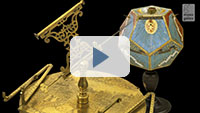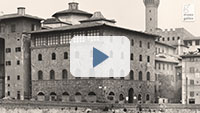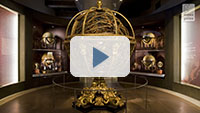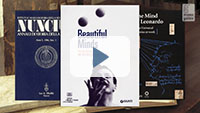§ I. History of the collections
The instrument collections of the Museo Galileo of Florence are among the most important in the world. These collections bear eloquent testimony to the promotion of scientific research, first by the Medici dynasty, then by the Grand Dukes of Lorraine.
From Cosimo I onward, the Medici Grand Dukes collected instruments of extraordinary beauty and innovative design. The Medici scientific collection was initially kept in the "Sala delle Carte" [Map Room] in the Palazzo Vecchio. It was later moved to the "Stanzino delle Matematiche" [Mathematics Study] and the adjoining "Sala delle Matematiche" [Mathematics Room] in the Uffizi Gallery.
The steadily-growing scientific collections remained in the Uffizi, along with masterpieces of the figurative arts and many natural wonders, until the mid-eighteenth century, when they were separated from the artistic collections.
§ II. The first science museum
The Medici scientific collections were transferred to the Museo di Fisica e Storia Naturale [Physics and Natural History Museum], founded by Grand Duke Peter Leopold in 1775. There, the collections were enriched by conspicuous acquisitions of new instruments and experimental apparatus. Under its first director, Felice Fontana, the Museum became an important center for research and diffusion of scientific culture.
In 1841, on the occasion of the Third Congress of Italian Scientists, the Tribuna di Galileo was built in the Museo di Fisica e Storia Naturale. The more important instruments of the Medici collection were showcased there, together with those invented and used by Galileo and by the Accademia del Cimento.
In 1860, as a consequence of the unification of Italy, the Museo di Fisica e Storia Naturale was shut down. Most of the collections were donated to the departments of the Istituto di Studi Superiori, the predecessor of the University of Florence. Only the ancient instruments and the zoology and anatomy collections remained in the original location.
Ownership of the ancient scientific collections passed to the University of Florence at its foundation in 1925. To ensure their conservation and proper display, the Medici-Lorraine collections of scientific instruments were handed over to the Museo di Storia della Scienza [History of Science Museum]. The Museum was opened in 1930 in Palazzo Castellani, which remains its home to this day.
Thanks to the commitment of its first directors, Andrea Corsini and Maria Luisa Righini Bonelli, the Museo di Storia della Scienza of Florence established itself as an internationally recognized center for conservation, popularization, and research.
In recent years the Museum displays have been completely redesigned; the Library has become the Italian reference center for studies in the history of science and technology and in scientific museology. The Institute has organized international meetings and seminars, training courses, and high-profile traveling exhibitions. It has published a wide range of works of scholarly and general interest. The Institute has developed educational programs as well as innovative multimedia products.
§ III. The present setting
In 2010 the Istituto e Museo di Storia della Scienza changed its name to Museo Galileo. Its scientific-instrument collections contain more than 5,000 items, about 1,000 of which are on permanent exhibit in the 18 rooms currently open to the public. The displays cover two floors of the Palazzo Castellani. The rooms are arranged by time period and topic.
The first floor is dedicated to the instruments of the Medici collections, exhibited in nine rooms, where visitors can admire fine mathematical instruments, Galileo's original instruments (including the two surviving telescopes of those personally made by the Pisan scientist), the instruments of the Accademia del Cimento, and the extraordinary collection of terrestrial and celestial globes, dominated by the monumental armillary sphere built by Antonio Santucci.
In the nine rooms of the upper floor the scientific activity of the Lorraine period is illustrated by: the conspicuous Tuscan - and, more generally, Italian - contribution to the development of electricity, electromagnetism and chemistry; the extraordinary series of obstetrical waxes; the chemistry cabinet of Grand Duke Peter Leopold; and the beautiful and instructive machines for demonstrating the basic principles of physics, built in the workshop of the Museo di Fisica e Storia Naturale.
§ IV. Promoting the scientific heritage and disseminating scientific culture
In Italy, country of museums par excellence, and in Florence, internationally known as the unrivalled "city of art", the presence of the Museo Galileo and its promotion of the history of science remind the millions of tourists that Florence and Italy have been centers of excellence not only for art and architecture. They have also been home to individuals and institutions that have contributed decisively to the advancement of technical and scientific knowledge. Visiting the Museum and its exhibitions, one becomes aware not only of this often neglected aspect, but also of the deep, continuous interaction between scientific research and artistic creation in Florence.
The Museo Galileo is committed to promoting the scientific heritage and disseminating scientific culture. These initiatives are of particular significance today, given the natural tendency of "global" tourism to select itineraries strictly confined to the highlights of artistic and architectural traditions.






